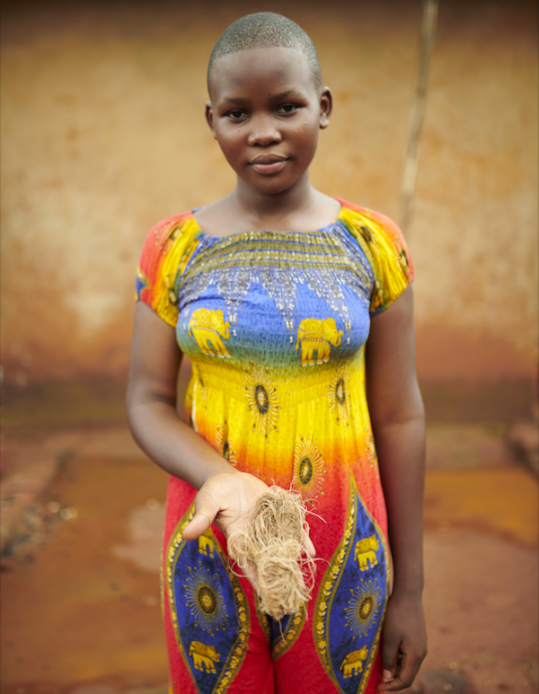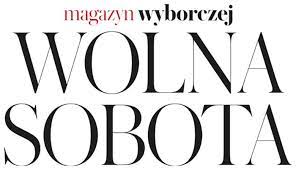Portraits of women with pads

The pretty girl in the yellow dress in your photo is holding something in her outstretched hands. What is it?
It’s her sanitary pad.
Looks like soil.
Because it is soil. This girl is from Uganda. She took part in a project on menstrual poverty. The soil she is holding serves as a menstrual product. In her village, when women get their periods, they go to a certain place and sit on the ground. You sit on the ground because you’re unclean. The blood soaks into the sand like into a sanitary pad. Because the women in this village don’t use sanitary pads. They’re not available. How does that make the person feel? What do they think?
It’s shocking.
I was moved by the blue sock with blood on it. That period item was demonstrated by another Ugandan resident.
My imagination is captured by the photo of the underwear with the leaf in the place where we would expect to see a sanitary pad. These pictures aren’t fake?
They’re not. It’s only to us from the position of a middle-class European that it may seem unbelievable. When we invited women to participate in this initiative, we asked them to show what they associate with menstruation, what it is for them, what challenges it brings. And they opened up. They showed us their world.
What for?
The idea was born during my cooperation with the Kulczyk Foundation. We talked a lot with Dominika Kulczyk about her projects, including the one concerning the fight against menstrual poverty. Dominika suggested I go with her team to Uganda, where an episode of her programme “Domino Effect” devoted to this topic was filmed. I made an attempt to show menstrual poverty in the pictures. I knew the problem existed, but I had never considered before how serious it was.
How did you convince women to open up like that?
I knew from the beginning that I was asking a lot. I also had to really give some thought to how to approach this subject from a photographic point of view. Menstruation is a difficult and sensitive, embarrassing topic. And I’m a man. I didn’t really see myself as a photographer who goes into this fragile world with his camera and documents it. I had to think carefully how to tell this story so as not to embarrass the heroines or make them feel uncomfortable. I offered to do portraits of women with pads. And then we would hand out cameras to them so that it was their eyes and hands that were an extension of mine. So they could document part of their lives, and I could put these images together with my own. I thought it would be easier for them.
Was it?
I think so.
Then I’ll ask you again, why?
To make people aware of the magnitude of the problem. A lot of people have no idea what menstrual poverty is. Others seem to know, but – just like I didn’t before – don’t know how massive its scale is. We think it’s the lack of access to hygiene products. “What’s the problem? After all, pads aren’t expensive”, some people say. In that case, imagine that there are women around the world who, during menstruation, put a small plank inside their panties which soaks up their blood. Or use torn rags. These are the pictures that my Ugandan models took. For one portrait a woman posed with a spread out newspaper. It’s not about reading the news. The newspaper was used as a hygiene product. I was amazed by the tangled fibres the women photographed. The fibres look a bit like straw and the women told us about them. They cut down banana stalks, and these trees grow in Uganda at every turn. Women tear these fibres apart, hammer them for a dozen or so minutes, and then use what comes out as a sanitary pad.
Maybe it’s a custom, a tradition?
That too, but there are simply no menstrual products, or they are too expensive for poorer women and girls. They’re conscious women, after all. They know that sand, an old sock or crushed banana fibres are neither comfortable nor hygienic. But that’s what’s available.
How did a guy, a photographer associated with big fashion shoots, come to tackle the topic of menstruation?
Just because I’ve done big fashion shoots doesn’t mean that’s my only area of photographic interest. It just so happens that I am concerned about social issues. I worked on a disability-related programme that fought stereotypes. I’ve done quite a few sessions for cancer foundations. My friend Agnieszka Lasota had cancer. I took pictures of her and other cancer patients. Some of them are unfortunately no longer with us. The photos don’t show death. The subjects are smiling, even though there are tears in their eyes.
Menstrual poverty is also a social issue. When I started to learn more about this topic, I realised that we have to act in this matter too. And that I, as a photographer, can do that. Even though no one in my house pretended that menstruation didn’t exist, even though I considered myself an open person, I was still embarrassed to talk about menstruation. Or even more so to persuade someone to confide in me in this matter. However, I was firmly convinced that menstrual poverty was not only an issue for those who experience it. Just need to make the rest aware that this phenomenon can and should be fought. I want to show a cultural problem – because it is the culture in the Ugandan countryside that makes a woman bleed on the sand.
I wonder how you managed to convince women to show such intimate issues and talk about them.
When I went to Uganda, I had a lot of doubts. I didn’t want to be perceived as an intruder who wanted to invade someone else’s world. I couldn’t imagine walking up and saying, “Good morning, we are doing such and such a project here. Can I take a picture of you with a sanitary pad?” My gender, cultural differences, and the very fact that I was supposed to be talking about physiology made me uncomfortable. I was embarrassed – that’s a good word. That’s when I got the idea of giving the cameras to the women. I was hoping that would help a little. But I admit, I didn’t expect such openness on the part of the women. There were, of course, those who refused to participate in the project. But there were times when we talked to one woman and her relative or friend said she wanted to join in as well. In these humble homes, in difficult conditions, we met courageous and strong women.
What do you think made them want to talk about menstruation so openly?
The fact that this problem affects them, hurts them, annoys them and makes their life difficult. They’re sick of it and want to show their anger to the world. They’re not cut off from the world. They have the Internet. They know there’s another way to live. Menstruation doesn’t have to mean so much discomfort, embarrassment, it doesn’t have to be a break from going to school or a reason to treat a person like an unclean being. It seems to me that this project is like an outcry: “See us and help us!”
These pictures have a strong message. They definitely hit home.
That’s good. That was the intention. The point is to wake people up. I was very touched by that experience too. I now know that it’s worth breaking through the awkwardness, because it’s the only way to show the world that women in the 21st century face such discomfort every month. And they don’t have to. My photos, as well as the photos of two other photographers – Łukasz Bąk and Tomasz Lazar, who also collaborated with the Kulczyk Foundation, can be seen at the “Otwórz oczy i zobacz” (“Open Your Eyes and See”) photography exhibitions in various Polish cities. And I’m thinking to myself, or actually hoping that the pictures will start conversations about menstruation. Maybe some little boy will overhear that making jokes when a friend is on her period is not allowed. Maybe the photographs will make someone think, make them realise that there is a problem.
And not that far away either. In Poland, many women admit that they sometimes had to choose whether to buy sanitary pads or something to eat.
I was thinking the same thing. One of the women in Uganda was talking about the trauma she suffered when she got her period at school and had no way of securing herself. So many situations like this happen in our country! Even if Polish women don’t sit in the sand during their menstruation and don’t use banana leaves, they also experience a lack of access to toilets, hygiene products, they are victims of indiscriminate comments, they are embarrassed and humiliated. I have no doubt that this is a universal problem. I am sure that women from the Polish countryside, from poor homes, have stories to tell that are no less poignant than those I heard in Africa. And that in the big cities, in the midst of all the wealth, there are also women who have to choose whether to buy a sanitary pad or food.
Marek Straszewski - started taking pictures when he lived and worked in France, where he emigrated to in 1988. After returning to Poland in the 1990s, he began working with the “Elle” magazine, with which he collaborated for over 20 years. Over time, apart from fashion photography, he also developed an interest in artistic and social activities. This is what he does most often these days. At the same time, he has expanded his activities to include video and music. Last year, together with the Kulczyk Foundation, he worked on a project on menstrual poverty in Uganda.
Author: Agnieszka Urazińska
Pictures from Uganda on menstrual poverty can be viewed on his website at http://marekstraszewski.com/2021/06/27/menstrual-poverty/
The text was published in „Wolna Sobota” a magazine of „Gazeta Wyborcza” on 4 September 2021


